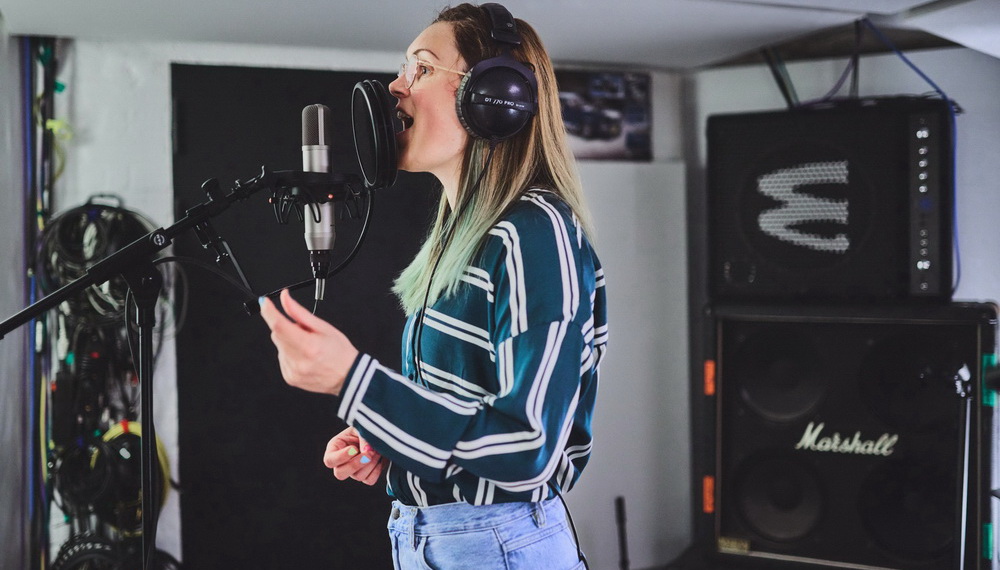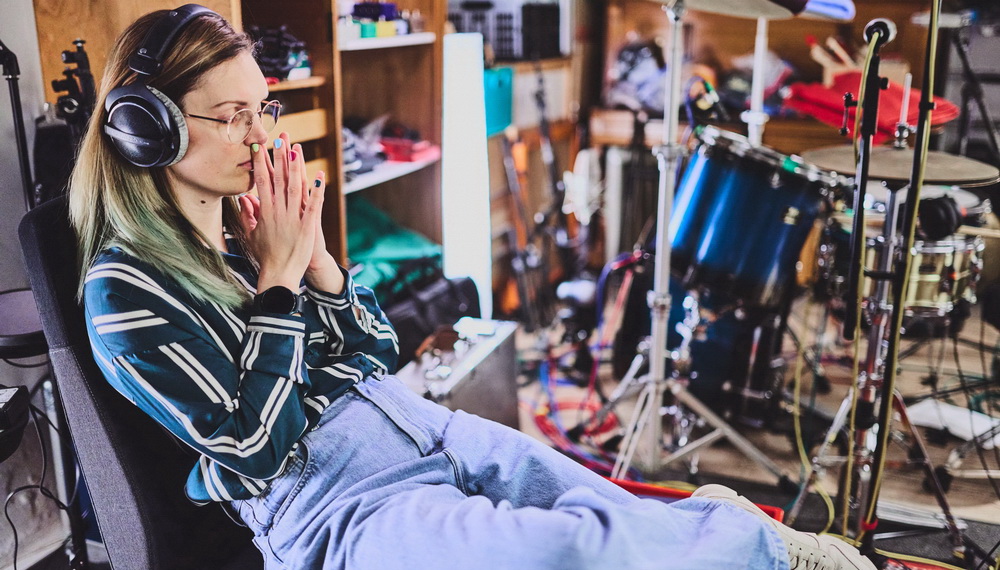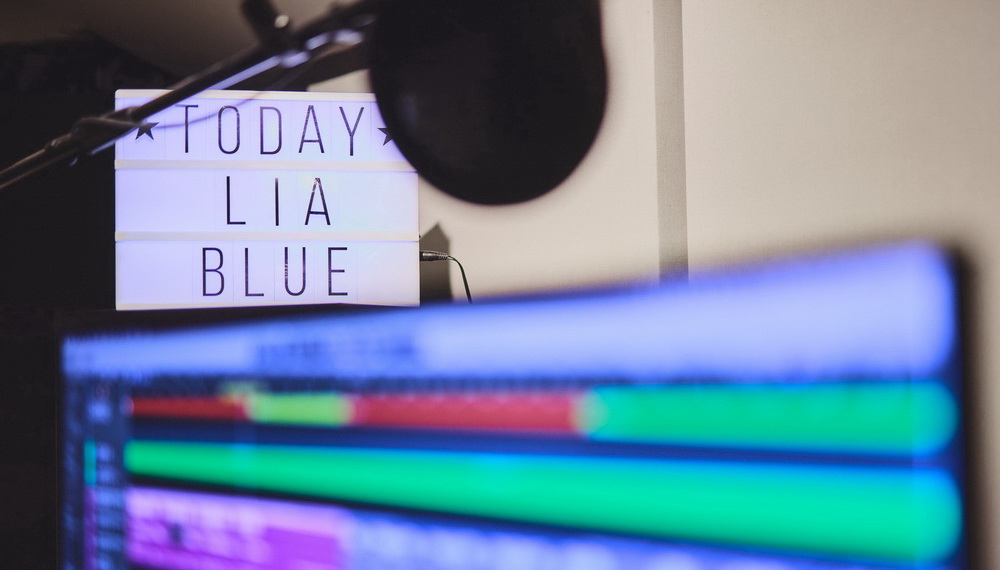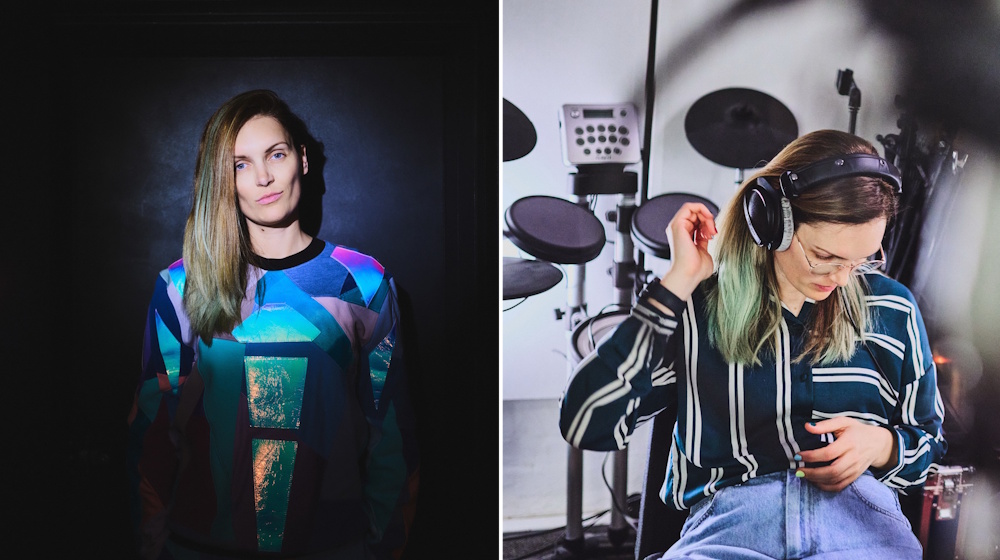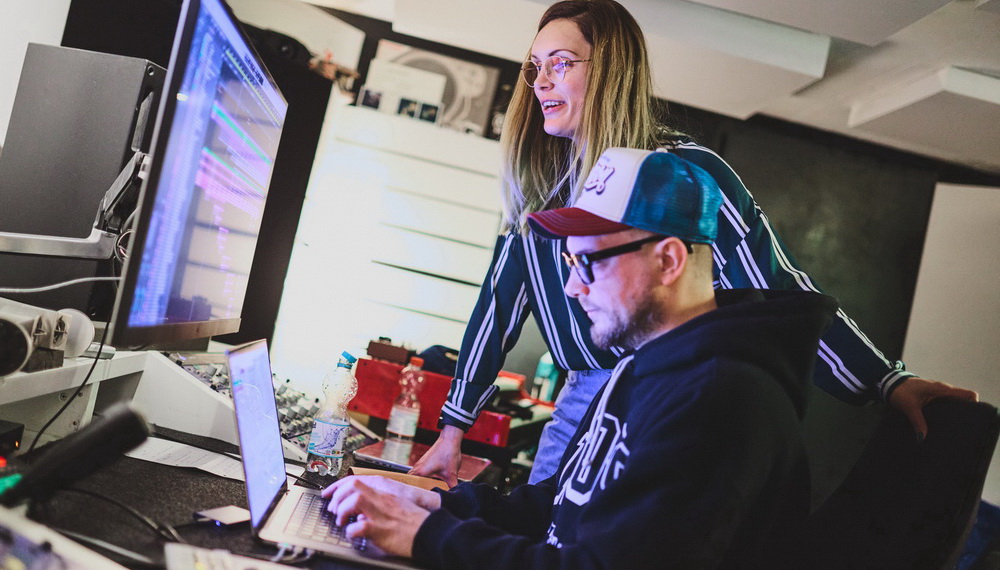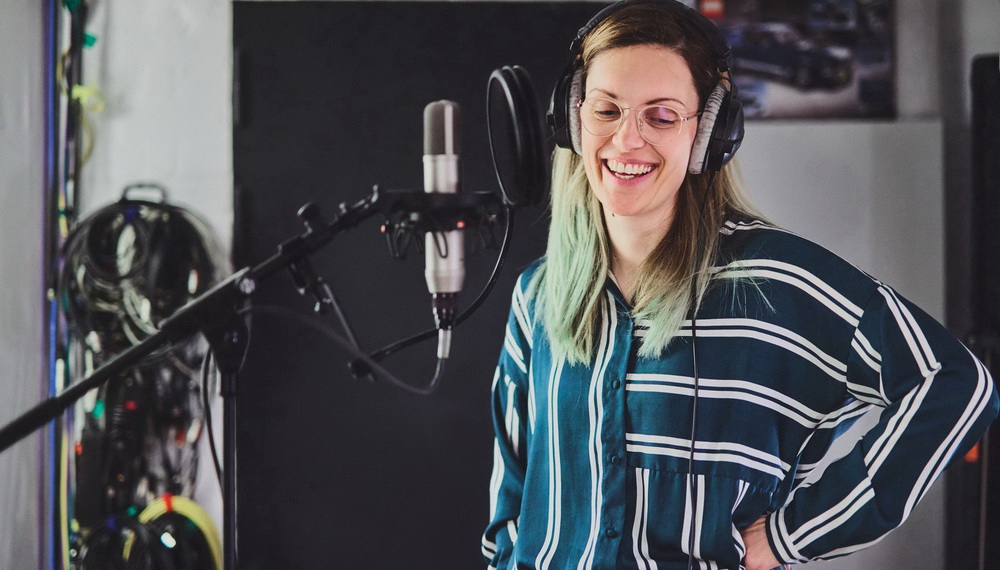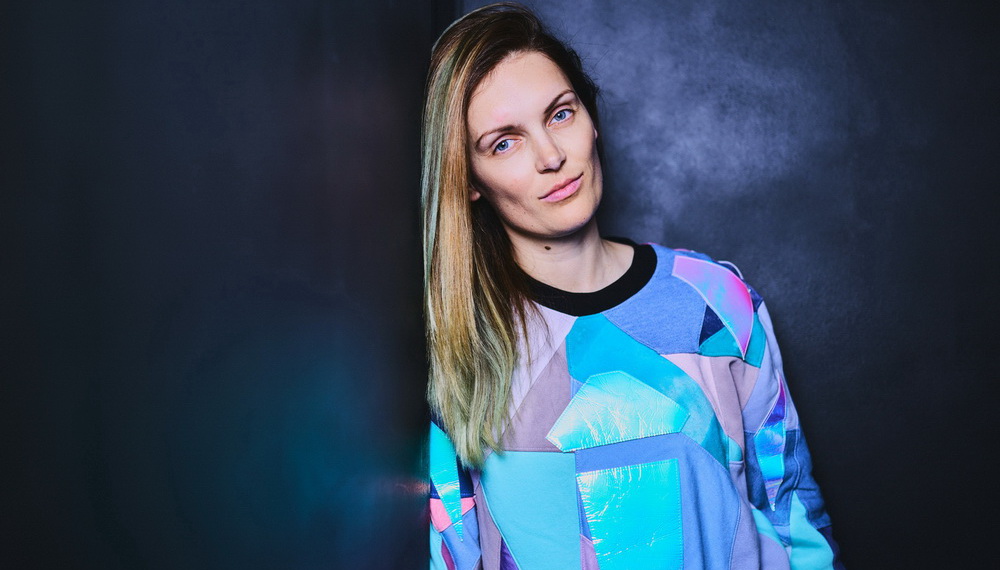Rostock-bred Lia Blue discovered the electronic music scene in her early teens, absorbing the minimalism of Apparat and Nina Kraviz while exploring the emotional lyrical content of artists like Joni Mitchell and Björk.
After studies in music production, she started to explore different electronic avenues, recording her first demos, and developed her characteristic electronic sound. Fast forward to 2025, and Lia is just about to release her sophomore album Skyphoria (tomorrow, 10 October), a brilliant blend of her melancholic and energy-boosted electronic soundscapes, followed by her first solo tour.
We sat down with Lia for a chat during her recording sessions at Sounds Like A Million Studio in Hamburg and talked about going DIY, writing songs during personal struggles, and being a FLINTA* artist in a male-dominated music scene.
Learn to know Lia Blue
Moin! Thanks for taking the time to talk to us. How about introducing yourself in a few words: who are you, and what do you do?
Hi, I’m Lia Blue from Rostock, and I make Blue Pop. That’s what I call my style – I make melancholic music but with some energy to it.
You’re a DIY artist, and you’ve been making music since 2006. In 2015, you set up your first home studio with very simple means, right?
Yes, when I’m making music, I sit down in my studio, which has gotten slightly bigger over time. I turn on my PC and play synths or look for drum samples, which I might end up recreating to tweak them a bit. I also play guitar, I have a piano at home, and I also record my vocals. That’s how most of my songs come about – first, I create the musical foundation, and then I add vocal layers.
What does DIY mean to you in the bigger picture? Is it the result of your musical roots, or is it about musical freedom and being independent?
There’s quite a long story behind that. At first, I only had an acoustic guitar; that’s how I used to write my music. Of course, at some point, I wanted to perform them on stage, but I couldn’t really imagine me playing the guitar by myself, and I felt like I needed someone else by my side. That idea grew into a band – and then there were three of us. We quickly moved in an electronic direction, which I really liked.
It had always been a dream of mine to start a kind of music family, like brothers and sisters, and go on tour together, and make a record together. And I also wanted to be on stage and focus on the vocals, not playing lots of instruments. But it didn’t work out in the end because I became very ill and fell into a really deep hole and felt like I had nothing left. But on the back of that, I thought it was time to actually believe in myself, that I could do it, and go even more independent by pushing myself out there.
The thing is, I wrote most of my songs before I could sing, made the musical parts, and arranged it all in my head, but I had always been dependent on the other two. But then I thought, ‘I can do this on my own’.
The music comes from within me, all these ideas, and I’ve always had a very clear vision of how songs should sound, so I sat down with my PC and spent something like sixteen hours a day watching tutorials. And that’s how I taught myself how to work with music production software, from playing a MIDI note to mastering. I learned all of this within two years, and then released my first five-song CD.
You are also a teacher and work on a school project teaching music. Was it natural for you to pass on what you learned through your self-studies to your students?
My decision to teach music at school started with the fact that, as a young person, I didn’t have the opportunity to learn such things at school or at home. The only thing I had was my mum’s old guitar.
When I started taking music seriously, I was already 25, and I thought, ‘Man, couldn’t I have started ten years earlier? Then I may have been where I am today when I was younger.’ I wanted to give my students what I didn’t have myself – a chance to explore their talents early in life, develop their creativity, and try things out. You know, like understanding the basics of music production. Is it something for me? Do I want to continue working in this direction? Just give them the chance to live out their creativity, which is something that schools have lost in this day and age.
It makes me so incredibly happy to see them sit there in front of the computer, just 13 or 14 years old, saying, ‘Ms, would you like to hear this?’
That sounds fantastic. How exactly are you working on this school project?
First, I encouraged the kids to think about what they want to express with their music and what music sparks within them. They were asked to pick their favorite songs and take a closer look – what’s in them? What instruments are used? What are the lyrics about? What happens inside their heads when they listen to the songs? What does it take to produce a song like that?
Then I just packed up my entire studio from home and loaded it into the car. At school, we all unloaded it together, each carrying a small suitcase. I let the kids set it up and didn’t say much, just something like, ‘You can see that there are cables and outlets on the devices. Now you just have to try out which cable fits where – go ahead. The task is complete when music comes out of the speakers.’ (laughs)
When we started working with music software for the first time, they looked at me with their eyes wide open – it was incredibly exciting! Everyone asked tons of questions – it was like running a marathon.
We started with fourteen children, and six stayed to the end – and they work with total focus.
And you also release music together?
Yes! At the beginning, we all worked on one song together so that everyone would learn how everything worked. From the very first note to the song title and designing the cover, we did everything together. You can listen to it on SoundCloud.
Some of the kids also started on their own right away, like ‘Cool, what is this? I can make my own music. I press that button and a sound comes out.’ I listened to it at home and was thrilled. You could tell that there is some real talent at work.
This week, one of my students made a cover for one of her songs all by herself and explained her thought process to me, ‘It’s got that 90s vibe, kind of like disco music’ (laughs), and the cover reflected that perfectly. I thought it was really cool.
Crafting beats and breaking rules
Many successful artists started their journeys from the confines of their bedrooms, using their creativity to make art with even basic tools. The notion of going completely DIY or signing to an independent label has given form to a musical landscape that shows no qualms in playing with the notion of exploring newfound sonic territory.
Lia guides us through her influences and musical inspiration while also elaborating on exploring new avenues for EDM music and how her songs are written during times of great struggle.
The 90s is a good transition; I can definitely hear some trance influences from the 90s in your new music. When I think back to that time, I remember lots of hit songs with female singers, but nobody knew their names or what they looked like. Even current EDM artists like David Guetta, Paul van Dyk, or Tiësto use uncredited female vocalists, and, sad to say, they seem like nothing more than a means to an end for these projects.
On the other hand, you are a completely self-sufficient DIY artist who wants to be seen that way. What is exciting about that for you? What defines you as a person and a musician?
Me wanting to have control of every step in the process probably stems from the fact that I always felt a bit controlled by others when I was younger, and as if I was only doing what was expected of me. The first song I wrote, defining my own style, was “Puppet on a String”, and that song made me break free from those chains, so to speak.
That was the point at which I decided to do everything myself. I wouldn’t accept being controlled by any outside force or person; no one would give me orders anymore. I wanted to be this confident woman who stands there and says, ‘I did this, this is my product. No one can take that away from me’, and I wanted it to stay that way.
In general, I’m the kind of person who, when having a problem, has to solve it. I can’t stop until there’s a solution, even if it takes three or four hours, and I’d feel like throwing my PC out the window while doing it (laughs). If I want to rearrange my apartment or my studio, I do it; I don’t want to wait until someone pops by to help me out. That’s how it is with music now, too. It’s difficult for me to hand it over to someone else. In the end, I want to stand up and say, ‘Yes, I made that electronic sound exactly like that, it was my idea!’ That strength and confidence I’ve developed along the way, and it can also be heard and felt in my music.
Ultimately, it‘s true self-empowerment that seems to be a recurring theme for you, right? You describe your music as ‚anti-small talk‘. In the EDM world in particular, lyrics tend to be rather banal, but in your music it’s the complete opposite. I find it really exciting to see how you manage to connect your inner world with lots of musical energy.
Did this development come about organically, or did you have to think outside the box of what EDM is and what rules apply to it?
I think that was also about development. When I think back to my very first song, it was a happy tune, a totally catchy song to dance to, but the lyrics were heartbreaking. That also has a lot to do with my musical influences, like Portishead and Archive, that’s really deep, melancholic music, or The XX, London Grammar, and Daughter. I totally identified with that; there’s a lot of substance there. It’s minimalist music, but in its simplicity, it can replace an entire orchestra.
At some point, I started redefining my songs in this direction. But at the same time, I always felt that I had to break free, that it was too quiet for me. Then I found new inspiration in Florence + The Machine, and slowly realized, ‘Yes, this is where I feel at home now! I can have depth in the lyrics, but feel really liberated in the music.‘
For me, it has always been the case that my songs were written in times of great struggles, but they also acted as a catalyst to catapult me out of this vortex that was pulling me further and further down. You can feel the energy I release through the music; it‘s in the wild basslines or synth parts. And when a drum set is added on top of that, everything explodes – that’s totally me. The intensity I feel in my life is what you should feel when you listen to my music.
This duality makes your music very exciting, and it’s fantastic that you aspire to be deep. After all, EDM doesn’t have to be just la la music.
Yes, exactly. With EDM, you often notice it right away: it‘s generic lyrics that sound good, and everyone can relate to them and sing along. And then you find out that it was a group of ten men writing it, and they just look for a voice that interprets it good enough and comes into the studio to record it. It doesn’t tell a story, and that has always bothered me. When I hear such corny phrases, it really hurts my ears. You’ve heard them a million times before, so I can’t connect with them. From the beginning, my goal was to produce something more profound.
For example, my song “Bluephoria“ – of course, it’s catchy – doesn‘t have much lyrics at all, but it has this message behind it. There’s a reason why I repeat myself constantly in this song and only sing two sentences. For me, it’s the idea behind it that matters.
‘The idea behind it‘ is a good cue because there is also a common thread running through your albums and EPs. It started with Skypaint, then came Skyfire, followed by Skyphoria.
Yes, and next up is Skytopia.
I can still remember that moment so clearly when I was standing in the garden of this huge house I shared in the center of Rostock, looking up at the sky and thinking, ‘It really looks like a painting.‘ That was the birth of Skypaint, and then there were my songs on that theme, like “Phantom Sky“ and “Skyscrapers“. Why always the sky? I think everyone around me also was confused at one point because the word ‘sky‘ was everywhere (laughs).
Today, I live in an attic apartment where I can see both the sunrise and the sunset, and the sky always looks different. These sunsets are just amazing. This closeness to the sky – I think that’s where my creativity comes from, from nature. I associate all these natural spectacles with it. It sparks something inside me when I see a foggy landscape! This closeness to nature quite quickly made it clear that my central theme would be the different states and shapes of the sky.
We can see that in the colors you work with, right?
Yes! Skypaint was black and white, a bit like those dreary, foggy days. Skyfire was more like a sunset, and Skyphoria was the pastel tones that sometimes appear just before sunrise and after sunset. Skytopia is a bit darker again.
Being a FLINTA* in male-dominated music spaces
As an artist who performs alone on stage, you probably have a lot to do with male technicians.
99%! (laughs)
I thought so! As a FLINTA* who has mastered the craft for some time by now, do you experience that you get underestimated? Do you sometimes wish people treated you differently as an artist?
Yes, one incident in particular comes to mind. I was setting up for my soundcheck, and there were at least six men in this small room. When I’m setting up, I’m always very focused and don’t really think about me being a woman who‘s going, ‘I’ll show you all now.‘ I just enjoy the moment, and when the first tunes come out, it’s great.
But there was this group of men standing there, examining me and having a really unpleasant conversation, joking among themselves. They said – and I heard it too – ‘Should we call the vet with all these cat cries?‘ In that moment, they were looking down on me. Why do people have to do that? I didn’t understand it at all.
That’s when I started to think that people might underestimate me just because I’m perceived as female. But that also spurred me. In that moment, I didn’t feel angry at all. For me, that always comes afterwards, when I reflect on it and don’t understand why people don’t believe in men, and that I can‘t do it just because I don’t have a penis.
Another time, I had an encounter with a choreographer. I was in one of her workshops, and it was about stage presence. At the time, I had really short hair, and she said, ‘Yes, it would actually be really cool if you came on stage with long hair and showed that you’re a woman.‘ Why, actually? Why can’t I go on stage with short hair? Why do I have to conform to this sort of cliché?
These clichés and stereotypes have always pissed me off. Even as a child, I didn’t like it when my mom put me in dresses. I went to play soccer instead. And that’s exactly how I feel about music, too. Just because I’m a woman doesn’t mean I can’t learn all this stuff myself and then get up on stage and set it up.
Mastering the technology is then also a logical consequence, right? Because that is also important in order to be “taken seriously”, something that wouldn’t be questioned if you were a man.
Do you know how proud it makes me that I, today, have three girls and three boys in my music production class? They don’t think about it at all. From the start, it was mainly the girls who set up the studio while the boys stood there with cables in their hands, not knowing what to do with it. But when girls in particular, who are not expected to be able to do this, are confronted with it at an early age, they have the opportunity to break down that barrier at some point.
In your press text, I read the beautiful sentence, ‘I come alive on stage. Nowhere else do I find such strength.’ Is the stage your safe space?
People have always perceived me as rather introverted, especially back in school. But when I was on stage, I suddenly became super extroverted, coming out of my shell and finally being able to be the person I am.
I kind of see the stage as a space to let out everything that was hidden before. As soon as the first tune plays, I’m at full focus and can let out all my energy, and I get so inspired when there’s an audience that picks up on that.
I wouldn’t be able to deal well with an audience that sits quietly with their arms crossed the whole show. That’s why I need lively music to get them into the vibe. In that moment, it’s a safe space for me, but also where I can talk about more profound topics, psychological things, like those times I had to be hospitalized. When I feel that I can talk about such intimate things and no one looks at me with horror, it gives me a lot of strength. I feel comfortable when I’m allowed to present my music and see it captivate people.
What happens inside of you when you go on stage? Does the switch flip?
Yes, that’s when the switch flips. I’m 100% there. I don’t think about anything else and let myself being embraced by the music. I’ve created 95% of the sounds myself; that’s my form of expression. And when I hear it, I feel it very intensely, no matter how many times I’ve heard the song. And when I get to sing live to it, that’s life for me. Real life. True life.
That’s a wonderful closing statement, but we still have one question. Lia Blue 2025 – where is the journey headed?
I’m going on my first tour! I’ve been dreaming about this for ages, and now I’m about to make it come true.
One of the first tour dates isn’t even in Germany. That makes my heart sing, knowing that my music can take me beyond Germany’s borders. I’m an English teacher, and the language makes me feel at home anywhere in the world.
*****
Photographer: Julia Schwendner
*****
Lia Blue pages
 Messed!Up
Messed!Up
